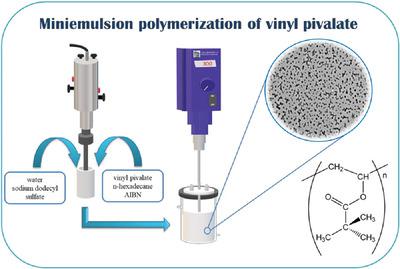当前位置:
X-MOL 学术
›
Macromol. React. Eng.
›
论文详情
Our official English website, www.x-mol.net, welcomes your
feedback! (Note: you will need to create a separate account there.)
Experimental Evaluation of the Miniemulsion Polymerization of Vinyl Pivalate: The role of the Main Process Variables
Macromolecular Reaction Engineering ( IF 1.8 ) Pub Date : 2020-12-23 , DOI: 10.1002/mren.202000049 Weslany Silvério Neto 1 , Gabriel Victor Simões Dutra 1 , Leonardo Fonseca Valadares 2 , Fernando Gomes Souza 3 , Marcelo Henrique Sousa 4 , Fabricio Machado 1
Macromolecular Reaction Engineering ( IF 1.8 ) Pub Date : 2020-12-23 , DOI: 10.1002/mren.202000049 Weslany Silvério Neto 1 , Gabriel Victor Simões Dutra 1 , Leonardo Fonseca Valadares 2 , Fernando Gomes Souza 3 , Marcelo Henrique Sousa 4 , Fabricio Machado 1
Affiliation

|
Poly(vinyl pivalate) (PVPi) nanoparticles obtained via miniemulsion have particular properties useful for several applications. Thus, the present study aims to synthesize and characterize PVPi nanoparticles through the miniemulsion polymerization process, studying the effects of water‐soluble and oil‐soluble initiators, polymerization temperature, and the co‐stabilizer concentration on the final properties of the polymer, nanoparticle size, and conversion. The polymeric nanoparticles are characterized by Fourier transform infrared spectroscopy, nuclear magnetic resonance (1H and 13C NMR), thermogravimetric analysis, differential scanning calorimetry, gel permeation chromatography, dynamic light scattering, and transmission electron microscopy. The miniemulsion polymerization process ensures the formation of a polymeric fluid with high colloidal and thermal stability, with maximum conversions of ≈85% and average particle diameter of 97.2 ± 21.8 nm. The polymeric properties, such as molar mass and glass transition temperature (Tg), are influenced by process variables such as synthesis temperature and the type of initiator. The use of potassium persulfate and 2,2‐azobisisobutyronitrile (AIBN) initiators favors the homogeneous nucleation mechanism, resulting in a decrease in the average particle diameter and in the growth of the chains, result in greater average molar masses and, consequently, greater Tg.
中文翻译:

新戊酸乙烯酯细乳液聚合的实验评估:主要工艺变量的作用
通过细乳液获得的聚(新戊酸乙烯酯)(PVPi)纳米粒子具有可用于多种应用的特殊性能。因此,本研究旨在通过细乳液聚合工艺来合成和表征PVPi纳米颗粒,研究水溶性和油溶性引发剂,聚合温度和助稳定剂浓度对聚合物最终性能,纳米颗粒尺寸的影响。和转换。聚合纳米粒子的特征在于傅立叶变换红外光谱,核磁共振(1 H和13NMR),热重分析,差示扫描量热法,凝胶渗透色谱,动态光散射和透射电子显微镜。细乳液聚合工艺可确保形成具有高胶体和热稳定性的聚合物流体,最大转化率约≈85%,平均粒径为97.2±21.8 nm。聚合性能,例如摩尔质量和玻璃化转变温度(T g)受工艺变量(例如合成温度和引发剂类型)的影响。过硫酸钾和2,2-偶氮二异丁腈(AIBN)引发剂的使用有利于均相成核机理,导致平均粒径减小和链增长,导致平均摩尔质量更大,因此T更大。摹。
更新日期:2020-12-23
中文翻译:

新戊酸乙烯酯细乳液聚合的实验评估:主要工艺变量的作用
通过细乳液获得的聚(新戊酸乙烯酯)(PVPi)纳米粒子具有可用于多种应用的特殊性能。因此,本研究旨在通过细乳液聚合工艺来合成和表征PVPi纳米颗粒,研究水溶性和油溶性引发剂,聚合温度和助稳定剂浓度对聚合物最终性能,纳米颗粒尺寸的影响。和转换。聚合纳米粒子的特征在于傅立叶变换红外光谱,核磁共振(1 H和13NMR),热重分析,差示扫描量热法,凝胶渗透色谱,动态光散射和透射电子显微镜。细乳液聚合工艺可确保形成具有高胶体和热稳定性的聚合物流体,最大转化率约≈85%,平均粒径为97.2±21.8 nm。聚合性能,例如摩尔质量和玻璃化转变温度(T g)受工艺变量(例如合成温度和引发剂类型)的影响。过硫酸钾和2,2-偶氮二异丁腈(AIBN)引发剂的使用有利于均相成核机理,导致平均粒径减小和链增长,导致平均摩尔质量更大,因此T更大。摹。











































 京公网安备 11010802027423号
京公网安备 11010802027423号